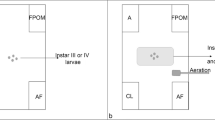Abstract
The larval stages ofAblattaria arenaria were provided with 4 different snail species:Monacha syriaca (Ehrenberg),Xeropicta derbentina (Krynicki),Candidula sp., andZebrina eburnea (Pfeiffer) to determine if the prey species affected developmental time and food preference of larvae. Functional response of each larval stage ofA. arenaria was also tested for increasing density ofX. derbentina, the most common prey species found in association withA. arenaria locally.
The developmental time of each larval stage did not show any statistical difference when fed with different snail species. The total developmental time from egg hatch to adult emergence was 19.0, 19.1, 18.0 and 21.4 days for prey speciesM. syriaca, X. derbentina, Candidula sp., andZ. eburnea, respectively. When prey was offered to larvae either as a single species or as combination of several species,M. syriaca was the most preferred. The prey least consumed wasCandula sp. when prey was given separately, andZ. eburnea was least preferred when other prey species were present in the arena. The 3rd larval stage did not eat anyZ. eburnea if other prey species were present.
The amount of prey consumed by the 1st larval stage did not show any statistical differences with increasing density ofX. derbentina. But the response of 2nd and 3rd larval stages was very similar to each other although the amount of prey they consumed was very different. They both showed a rapid increase in consumption rate at early densities, then a negatively but slowly accelerated rise to plateaus at higher densities, a type-2 functional response curve.
All larval stages were very sensitive to starvation. Mortality started after the 2nd day, and all individuals of all larval stages were dead by the 5th day.
Résumé
Les stades larvaires d'Ablattaria arenaria ont été nourris avec 4 espèces différentes d'escargots:Monacha syriaca (Ehrenberg),Xeropicta derbentina (Krynicki),Candidula sp. etZebrina eburnea (Pfeiffer) pour déterminer si l'espèce proie affectait la durée de développement et la préférence alimentaire des larves. La réponse fonctionnelle de chaque stade larvaire d'A. arenaria était aussi testée par densité croissante deX. derbentina, espèce proie la plus commune trouvée associée localement àA. arenaria.
La durée de développement de chaque stade larvaire ne montrait pas de différences statistiquement valables en fonction des différentes espèces d'escargots. La durée totale de développement de l'œuf à l'adulte était de 19,0; 19,1; 18,0 et 21,4 jours avec respectivement pour proie:M. syriaca, X. derbentina, Candidula sp. etZ. eburnea. Quand la proie offerte aux larves était une seule espèce ou une association de plusieurs,M. syriaca était la plus choisie. La proie la moins consommée étaitCandidula sp. quand la proie était fournie séparément etZ. eburnea était la moins choisie quand d'autres espèces proies étaient présentes dans l'environnement. Le 3e stade larval ne mangeait pasZ. eburnea si d'autres espèces proies étaient présentes également.
Le taux de proies consommées par le premier stade larvaire ne manifestait aucune différence statistiquement valable avec une augmentation croissante de la densité deX. derbentina. Mais la réponse des 2e et 3e stades larvaires était très voisine bien que le taux de proies consommées soit très différent. Tous deux manifestaient une augmentation du taux de consommation aux faibles densités, suivie d'une plus atténuée vers le plateau des densités plus fortes, soit une courbe de réponse fonctionnelle du type 2.
Tous les stades larvaires étaient sensibles au manque de nourriture. La mortalité débutait après le 2e jour et tous les individus, quel qu'en soit le stade, étaient morts dès le 5e jour.
Similar content being viewed by others
References
Avidov, Z. &Harpaz, I. — 1969. Plant Pests of Israel. —Israel Universities Press., Jérusalem, 549 pp.
Balduf, W. V. — 1935. The bionomics of entomophagous Coleoptera. —John S. Swift Co. Inc., St. Louis, Mo., 220 pp.
Fisher, T. W. &Orth, R. E. — 1985. Biological Control of Snails. —Occasional Papers. Depart of Entomol, University of California, Riverside. Number 1. pp + I-VIII.
Freude, H., Harde, K. W. &Lohse, G. A. — 1971. Die Kaefer Mitteleuropas. — Band 3,Goecke & Evers, Krefeld, 365 pp.
Holling, C. S. — 1959. The components of predation as revealed by a study of small mammal —predation of the European pine sawfly. —Can. Entomol., 91, 293–320.
Holling, C. S. — 1965. The functional response of predators to prey density and its role in mimicry population regulation. —Mem. Entomol. Soc. Can., 45, 60 pp.
Laing, J. E. &Osborne, J. A. L. — 1974. The effect of prey density on the functional and numerical responses of three species of predatory mites. —Entomophaga, 19, 267–277.
Messenger, P. S. — 1968. Bioclimatic studies of the aphid parasitePraon exsoletum. I. Effects of temperature on the functional response of females to varying host densities. —Can. Entomol., 100, 728–741.
Poole, R. W. — 1974. An Introduction to Quantitative Ecology. —McGraw-Hill, New York, 532 pp.
Sandness, J. N. &McMurtry, A. — 1970. Functional responses of three species of phytoseiids [Acarina] to increased prey density. —Can. Entomol., 102, 692–704.
Santos, M. A. — 1975. Functional and numerical responses of the predatory mite,Amblyseius fallacis, to prey density. —Environ. Entomol., 4, 989–992.
Schawaller, V. W. — 1979. Revision der GattungAblattaria Reitter 1884 [Col.: Silphidae]. —Stuttgarter Beitr. Naturk., Ser. A., 321, 1–8.
Uygun, N. — 1971. Der Einfluss der nahrungsmenge auf Fruchtbarkeit und Lebensdauer vonAphidoletes aphidimyza (Rond.) [Diptera: Itonididae]. —Z. Angew. Entomol., 69, 234–258.
Author information
Authors and Affiliations
Rights and permissions
About this article
Cite this article
Sekeroglu, E., Colkesen, T. Prey preference and feeding capacity of the larvae ofAblattaria arenaria [Coleoptera: Silphidae], a snail predator. Entomophaga 34, 227–236 (1989). https://doi.org/10.1007/BF02372672
Received:
Accepted:
Issue Date:
DOI: https://doi.org/10.1007/BF02372672




